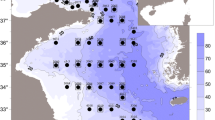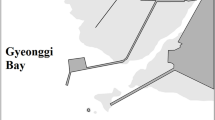Abstract
A Zürich-Montpellier analysis provided more detailed information about pelecypod associations in two sediment beds than either a traditional subjective approach or a cluster analysis based on Jaccard's coefficient. The Zürich-Montpellier test separated till and sand pelecypod associations, and indicated distinguishing species and atypical samples. Species distinguishing the till association were Cardita ventricosa, Yoldia myalis, Semele rubropicta, Venerupis kennerlyi, Clinocardium nuttallii, Nuculana minuta and Macoma incongrua. Species distinguishing the sand were Macoma elimata, Compsomyax subdiaphana, Yoldia ensifera, Macoma calcarea, M. lipara, M. brota, Yoldia limatula and Macoma alaskana. Two samples contained species from both associations plus some species rare elsewhere. Combined R-and Q-type grouping procedures, of which the Zürich-Montpellier approach is an example, are useful in evaluating benthic faunal similarities, but the suitability of various forms of the procedure needs further study.
Similar content being viewed by others
Literature cited
Bouyoucos, G. J.: A recalibration of the hydrometer method for making mechanical analysis of soils. Agron. J. 43, 434–438 (1951).
Dunnill, R. M. and D. V. Ellis: The distribution and ecology of sublittoral species of Macoma (Bivalvia) off Moresby Island and in Satellite Channel, near Victoria, British Columbia. Veliger 12, 207–219 (1969).
Fager, E. W.: Communities of organisms. In: The sea, Vol. II, pp 415–437. Ed. by M. N. Hill. New York: Interscience, Wiley 1963.
—J. A. McGowan: Zooplankton species groups in the North Pacific. Science, N.Y. 140, 453–460 (1963).
Küchler, A. W.: Vegetation mapping, 472 pp. New York: Ronald 1967.
Lie, U. and J. C. Kelley: Benthic infauna communities off the coast of Washington and in Puget Sound: identification and distribution of the communities. J. Fish. Res. Bd Can. 27, 621–651 (1970).
Peterson, C. G. J.: Valuation of the sea. II. The animal communities of the sea bottom and their importance to marine zoogeography. Rep. Dan. biol. Stn. 21, 42–68 (1913).
Sokal, R. R. and P. H. A. Sneath: Principles of numerical taxonomy, 359 pp. San Francisco: Freeman 1963.
Thorson, G.: Bottom communities. Mem. geol. Soc. Am. 67, 461–534 (1957).
Author information
Authors and Affiliations
Additional information
Communicated by T. R. Parsons, Nanaimo
Supported by the Defense Research Board of Canada, Grant No. 9520-23. Based on a thesis submitted by J. D. Popham to the University of Victoria in partial fulfillment of the requirements for the degree of B.Sc. (Honours).
Rights and permissions
About this article
Cite this article
Popham, J.D., Ellis, D.V. A comparison of traditional, cluster and Zürich-Montpellier analyses of infaunal pelecypod associations from two adjacent sediment beds. Marine Biology 8, 260–266 (1971). https://doi.org/10.1007/BF00355224
Accepted:
Issue Date:
DOI: https://doi.org/10.1007/BF00355224




